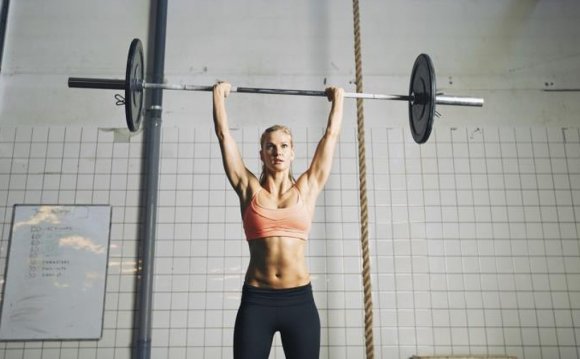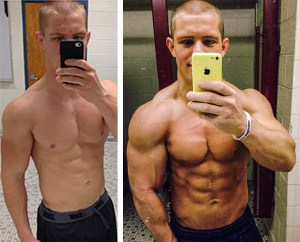
 Software engineer Andrew Balliet, 35, was in dire need of a transformation in 2012. He had been active in sports like ice hockey, skiing, and running throughout his adult life, but when a family tragedy and its aftermath forced him to the sidelines of his favorite activities, he saw his weight balloon up to more than 250 pounds.
Software engineer Andrew Balliet, 35, was in dire need of a transformation in 2012. He had been active in sports like ice hockey, skiing, and running throughout his adult life, but when a family tragedy and its aftermath forced him to the sidelines of his favorite activities, he saw his weight balloon up to more than 250 pounds.
Searching for a new foothold in fitness, Balliet and his wife used an online coupon to begin attending boot camp classes at a nearby gym. After these helped him lose a few pounds and feel better, he upped the ante by signing up for iSatori's 90-day Iron Warrior Challenge, and began more seriously lifting weights.
At first, he says, he measured progress through "measurements of inches in different parts of my body. My goal was to lose the fat." This technique worked for a while. But soon enough, he found an even more effective way to track his improvement.
"As fat disappeared, my method of assessing muscle mass improvements was the increased weight I was able to use during lifts, the amount of time I could perform exercises, and the definition that I could see in my body and face, " he recalls.
All of a sudden, Balliet wasn't just losing weight; he was also a faster, better hockey player and leading a more athletic and healthy lifestyle overall. In all, he lost 32 pounds during the challenge—and 96 combined inches from his various measurements.
Losing weight and gaining muscle are both possible. Andrew Balliet lost 32 pounds and managed to become stronger than ever in the gym.
"Building muscle tissue was one to the major keys in my transformation, " he says in hindsight. "The stronger I felt, the more motivated I was along the way. Building muscle helped me to burn extra calories. It made me feel good about myself. It helped me perform better at the activities I like to do. Additionally, my supplementation, especially with Eat-Smart, Bio-Gro, and Restoraid, helped keep me from getting injured and slowing my transformation goals."
 Monty Krough III of Pennsville, New Jersey, faced the opposite challenge. In mid-November 2013, the 18-year-old college student looked in the mirror at his scrawny 168-pound frame, and his spirits sagged like his pecs. He decided on the spot to add size and strength.
Monty Krough III of Pennsville, New Jersey, faced the opposite challenge. In mid-November 2013, the 18-year-old college student looked in the mirror at his scrawny 168-pound frame, and his spirits sagged like his pecs. He decided on the spot to add size and strength.
Monty started slamming Bio-Gro protein shakes down his gullet twice every day. He dialed back his cardio, and lowered his rep ranges a bit, although, at 10-ish, they still fell within the ideal range for hypertrophy.
By February 2014, Monty tipped the scales at 181 pounds, and had increased his strength! His bench press rose from 245 pounds for 10 reps to 295 for the same number of reps; his squat rose from 275 to 365. Mission accomplished, son!
Muscles Need To Be Fed
Somewhere in the last few decades, people everywhere began to confuse a healthy diet with "dieting." A healthy diet is balanced and can be altered or customized to achieve specific goals without becoming unhealthy. Dieting, on the other hand, is simple deprivation in the name of fat loss, and with it often comes physical weakness, unhappiness, and a decline in athleticism. "Don't confuse the two, " says Sandler.
Dieting is simple deprivation in the name of fat-loss. With it comes physical weakness, unhappiness, and a decline in athleticism. Know the difference between "dieting" and a "healthy diet."
 "Without doubt, maintenance of body composition is wrapped up in your diet, " he explains. "But you don't have to not eat, or drop all your carbs and chew on broccoli all day long." Extreme dieting, he says, denies the body what it needs to experience healthy growth in the form of muscle tissue. In the long term, surprisingly, it can also lead to fat gain.
"Without doubt, maintenance of body composition is wrapped up in your diet, " he explains. "But you don't have to not eat, or drop all your carbs and chew on broccoli all day long." Extreme dieting, he says, denies the body what it needs to experience healthy growth in the form of muscle tissue. In the long term, surprisingly, it can also lead to fat gain.
"There are people who under-eat and under-carb, and they rob their body of so many important nutrients and energy, that the body begins to normalize and even store in the absence of good fuel. It's critical to eat smart to ensure you fuel your muscle gains. I've helped many athletes and physique competitors learn how to improve their physiques by eating more."
Still, he recognizes that someone trying to lose large amounts of weight in a physical transformation sometimes has to eat in a caloric deficit. This shouldn't mean that balanced nutrition goes out the window.
"Rather than dropping off any specific macronutrient like fats, carbs, or protein, just drop your total calorie content by the percentage you need to hit your target, " he advises. "Try not to drop more than 500 total calories per day. Then, every week or two, go back over your nutrient intake and either continue to reduce slightly, maybe by another 100-200 calories per day, or keep the same, or perhaps even increase, if you are losing too much muscle."
Using muscle loss as a marker of when a diet has gotten too extreme is a good way to maintain a healthy approach, and make sure your body gets what it needs to keep up with consistent, intense training. Remember: You can eat any old junk to build fat. When you eat to build muscle, and give your muscles the fuel they require—like amino acids and bio-active peptides to assist muscle protein synthesis—you help the muscle keep growing, improving, and performing at a high level!
Muscles Take Time
As countless people have discovered, muscle and strength have a downside: they take time and hard work to build. So don't expect miracles overnight.
"Successful transformations take time—months to years, in fact—to become a way of life and prevent you from the roller coaster love-affair that the body has with fat, " says Sandler. "You'll need at least three good months of hitting the iron hard to see real results. Sure, you'll notice changes in the first week or two. You'll technically be stronger almost overnight. But, for changes you will be proud of, that people will notice, hitting the gym 3-4 times per week for a few months is important."
If you want to have a physique that will stay forever, you need to adopt the lifestyle that helps that to happen.
Once you achieve those hard-earned results, though, you'll quickly discover that's only the beginning. You'll want to hold onto them, right? This second chapter, which goes by the unsexy name of "maintenance, " is where the real changes happen, Sandlers says. "If you are just looking to get a one-time beach body, you can go for it, but if you want to have a physique that will stay forever, you need to adopt the lifestyle that helps that to happen."
After completing his 90-day iSatori Challenge, Balliet discovered that all the unhealthy foods and behaviors that he had said "no" to for three months were still there, as ready as ever to destroy what he had built. Standing up to them required a renewed commitment to strength as a lifestyle.
It wasn't easy, but his prize was well worth it: a healthy approach to life that keeps paying dividends in the gym and outside of it. "I've finally developed an exercise routine and a lifestyle of eating that works for me, my schedule, and my life, " he says.




INTERESTING VIDEO












